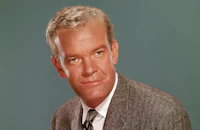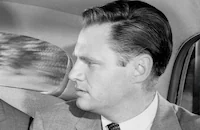The Glory Guys

Brief Synopsis
Cast & Crew
Arnold Laven
Tom Tryon
Harve Presnell
Senta Berger
James Caan
Andrew Duggan
Film Details
Technical Specs

Synopsis
Capt. Demas Harrod and his new recruits join the 3d Regiment of the U. S. Cavalry and find that the ambitious and opportunistic fort commander, General McCabe, is preparing to fight the combined forces of the neighboring Indian tribes. Demas has fallen in love with Lou Woodard, who lives in nearby Mule City. While visiting her one evening, he is interrupted by Sol Rogers, the regiment's chief scout, who plans to marry Lou. The two men fight and become enemies. Demas returns to the fort and is instructed to put his men through a crash training program, after which they celebrate their first leave in Mule City and run into trouble with the town marshal and his henchmen. Demas and Sol then conspire to avenge their men. At an officers' ball on the eve of the campaign, Sol realizes that Lou is in love with Demas, but Lou tells him that Demas seems to have lost interest in her. As the campaign opens, Demas becomes apprehensive when McCabe, disobeying his own orders, splits his forces, sending Demas against a band of Sioux. Demas' men suffer heavy losses, but they manage to retreat when they are joined by Sol. Demas and Sol, attempting to find water for the wounded men, are ambushed and Sol is killed. That night, after the Indians withdraw, Demas leads his reduced force to rejoin the regiment and finds that McCabe and his men, fighting the Indians on their own, have been massacred. He returns to the fort and to Lou.

Director

Arnold Laven
Cast

Tom Tryon
Harve Presnell
Senta Berger

James Caan

Andrew Duggan

Slim Pickens
Peter Breck
Jeanne Cooper
Laurel Goodwin

Adam Williams
Erik Holland
Robert Mcqueeney
Wayne Rogers
William Meigs
Alice Backes
Walter Scott
Michael Forest
George Ross
Dal Mckennon
Stephen Chase
Henry Beckman

Michael Anderson Jr.
Crew
Howard Beals
Frank Beetson Jr.
Jose Delfin
June Edgerton
Rafael Esparza
Clarence Eurist
Clarence Eurist
Marilyn Feibelkorn
Format Productions
Max Frankel
Arthur Gardner
Edward S. Haworth
James Wong Howe
Arnold Laven
Jules Levy
Joseph Mazzuca
Ray Moyer
Riz Ortolani
Al Overton Jr.
Sam Peckinpah
Donald W. Roberson
Lorraine Roberson
Ernst R. Rolf
Patricia Rose
George Ross
Melvin Shapiro
Roberto Silva
Westheimer Co.
B. C. Wylie

Film Details
Technical Specs

Articles
The Glory Guys
A widescreen western shot by the great James Wong Howe (three years out from his Oscar® win for Martin Ritt's Hud, 1963) and based on the 1876 massacre of the 7th Cavalry under George Armstrong Custer, The Glory Guys began with a novel by pulp western writer Herman Hoffman Birney. The Philadelphia-born Birney, son of a medical corps captain, was a World War I veteran who took from his military service with the Army Ballistic Missile Agency a passion for antique weapons and for informing his fiction with a high degree of historical accuracy. (Birney was also the long-seated western book critic for The New York Times and often took his colleagues to task for careless anachronisms.) A thinly-fictionalized account of the rout at Little Big Horn, Birney's 1956 novel The Dice of God was scooped up by film producer Jules V. Levy who, in partnership with Arthur Gardner and Arnold Laven, had already registered the title "Custer's Last Stand" with the Writer's Guild of America in hopes of giving the seminal prairie tale the big screen treatment. In November 1956, Levy-Gardner-Laven Productions took a gamble on a 31 year-old TV writer to adapt the material - Sam Peckinpah.
A former Marine who had cut his teeth in the industry as an assistant to director Don Siegel, Peckinpah could claim pioneer stock on both sides of his family. Born in Fresno, California, he had grown up on his grandfather's ranch, where he learned roping, branding, and shooting. For the task of adapting the Birney novel, Peckinpah was paid $500 a week; having a wife and two daughters to feed, he was able to stretch the work out until March of 1957, writing slowly but steadily through the interval, not breaking even to flee a canyon fire that threatened his home over the Christmas holiday 1956. Peckinpah tendered a 154-page script in the spring of 1957 but the project languished for seven years (and the title Custer's Last Stand was scooped by another producer), during which time the wannabe director got his start on the small screen, helming episodes of Broken Arrow, Klondike, and The Rifleman (the latter based on a script rejected for Gunsmoke that Peckinpah retooled for The Zane Grey Theater) and making his feature film debut as a director with The Deadly Companions (1961) and its follow-up Ride the High Country (1962). Produced at last by Levy-Gardner-Laven, under Laven's direction and released in July 1965 by United Artists, The Glory Guys ate the dust of Peckinpah's third feature, Major Dundee, with which it shares several themes key to the Peckinpah mythos and common cast members in Senta Berger, Slim Pickens, and Michael Anderson, Jr.
On its own terms, The Glory Guys holds its own as a rousing men-on-a-mission adventure, falling somewhere on the continuum between J. Lee Thompson's The Guns of Navarone (1961) and Robert Aldrich's The Dirty Dozen (1967). In addition to working out some of his key motifs and concerns in this early effort, Peckinpah was stamping a template that would be reused time and time again by practitioners of both westerns and combat films, bridging the first and final acts as he does with training montages depicting cavalry captain Tom Tryon putting his recruits through their paces, the expected internecine dustups (here between Tryon and Indian scout Harve Presnell over the love of the widowed Berger), the vainglory of politically-minded superiors (Custer surrogate Andrew Duggan) and the inevitable interaction with an outside demographic that unites the men into a fighting unit on the eve of their legendary confrontation with the Sioux nation. Given little to do beyond the obligation of comic relief, Caan makes his greatest impression in his final scene, electing to stay behind the retreating column and bury the commissioned officer who had been his greatest tormentor.
Producers: Jules V. Levy, Arthur Gardner, Arnold Laven
Director: Arnold Laven
Writer: Sam Peckinpah, based on the novel The Dice of God by Hoffman Birney
Cinematographer: James Wong Howe
Editor: Ernst R. Rolf, Melvin Shapiro
Music: Riz Ortolani
Cast: Tom Tryon (Cpt. Demas Harrod), Harve Presnell (Sol Rogers), Senta Berger (Mrs. Woddard), James Caan (Dugan), Michael Anderson, Jr. (Hale), Slim Pickens (Sgt. Gregory), Andrew Duggan (General McCabe), Peter Breck (Lt. Hodges), Wayne Rogers (Lt. Moran), Laurel Goodwin (Beth Poole), Jeanne Cooper (Mrs. McCabe), Paul Birch (General Hoffman).
C-112m.
by Richard Harland Smith
Sources:
"If They Move, Kill 'Em!": The Life and Times of Sam Peckinpah by David Weddle (Grove Press, February 2001) James Caan interview by Tony Macklin, Bright Lights Film Journal, 2008
"The Wrath of Caan" by Judy Tarshis, Smoke, Volume 4, Issue 1 Winter 98/99

The Glory Guys
Quotes
Trivia
Notes
Location scenes filmed in Durango, Mexico. Original title: Dice of God.

Miscellaneous Notes
Released in United States 1965
Released in United States 1965













